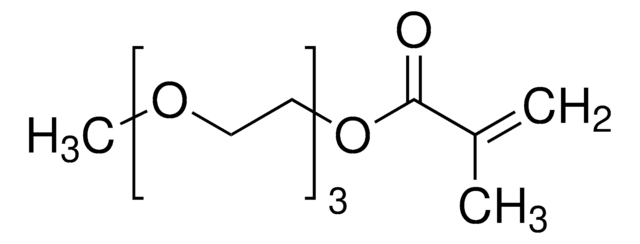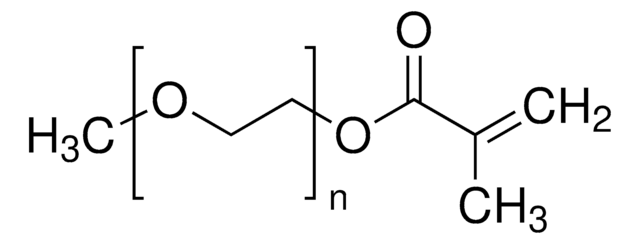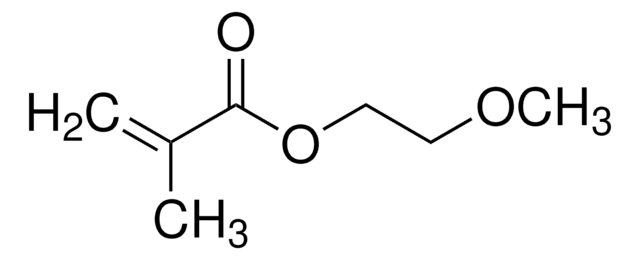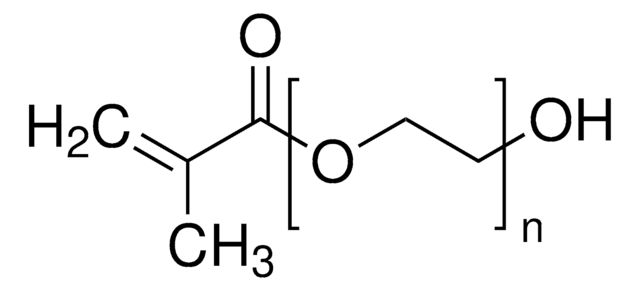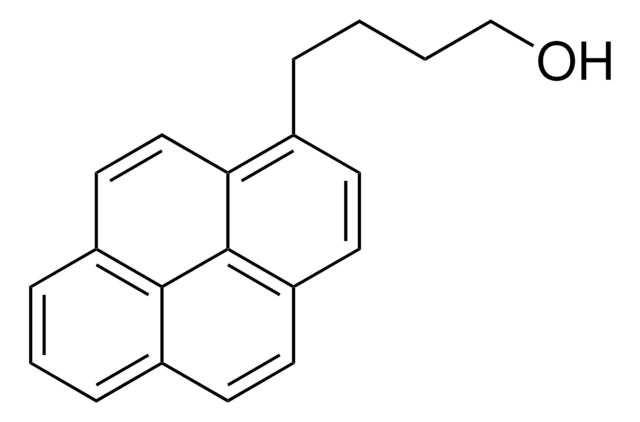추천 제품
Quality Level
분석
95%
포함
100 ppm hydroquinone monomethyl ether as inhibitor
300 ppm butylated hydroxytoluene as inhibitor
refractive index
n20/D 1.44 (lit.)
bp
98 °C/3.5 mmHg (lit.)
density
1.02 g/mL at 25 °C (lit.)
저장 온도
2-8°C
SMILES string
COCCOCCOC(=O)C(C)=C
InChI
1S/C9H16O4/c1-8(2)9(10)13-7-6-12-5-4-11-3/h1,4-7H2,2-3H3
InChI key
DAVVKEZTUOGEAK-UHFFFAOYSA-N
애플리케이션
- Tunable Cell-Adhesive Surfaces by Surface-Initiated Photoinduced Electron-Transfer-Reversible Addition-Fragmentation Chain-Transfer Polymerization.: This research utilizes Di(ethylene glycol) methyl ether methacrylate in the development of tunable cell-adhesive surfaces, crucial for biomedical applications such as tissue engineering and medical device manufacturing, due to its capacity for precise surface chemistry modifications (Kuzmyn et al., 2024).
- Temperature-Responsive Aldehyde Hydrogels with Injectable, Self-Healing, and Tunable Mechanical Properties.: This study demonstrates the use of Di(ethylene glycol) methyl ether methacrylate in creating temperature-responsive hydrogels, offering significant potential in medical device applications for minimally invasive surgical technologies and drug delivery systems (Zhao et al., 2022).
- Investigation of the Thermogelation of a Promising Biocompatible ABC Triblock Terpolymer and Its Comparison with Pluronic F127.: Highlighting its application in pharmaceutical formulations, this research explores the thermogelation properties of polymers including Di(ethylene glycol) methyl ether methacrylate, important for developing controlled drug release systems (Constantinou et al., 2022).
- Fabrication and Impact of Fouling-Reducing Temperature-Responsive POEGMA Coatings with Embedded CaCO(3) Nanoparticles on Different Cell Lines.: The study employs Di(ethylene glycol) methyl ether methacrylate in developing advanced coatings for biomedical devices, aiming to reduce fouling and enhance device longevity and functionality in clinical settings (Lishchynskyi et al., 2021).
- Nonionic UCST-LCST Diblock Copolymers with Tunable Thermoresponsiveness Synthesized via PhotoRAFT Polymerization.: This article presents the synthesis of unique block copolymers incorporating Di(ethylene glycol) methyl ether methacrylate, which are valuable in creating smart materials for dynamic biomedical and industrial applications (Xu & Abetz, 2021).
신호어
Warning
유해 및 위험 성명서
Hazard Classifications
Eye Irrit. 2 - Skin Irrit. 2 - Skin Sens. 1 - STOT SE 3
표적 기관
Respiratory system
Storage Class Code
10 - Combustible liquids
WGK
WGK 3
Flash Point (°F)
235.4 °F - closed cup
Flash Point (°C)
113 °C - closed cup
개인 보호 장비
Eyeshields, Faceshields, Gloves, type ABEK (EN14387) respirator filter
이미 열람한 고객
Xuejing Zhang et al.
Carbohydrate polymers, 221, 84-93 (2019-06-23)
In this study, we report a novel pH and temperature responsive paclitaxel-loaded drug delivery system based on chitosan and di(ethylene glycol) methyl ether methacrylate. This was functionalized with hyaluronic acid to permit active targeting of CD44-overexpressing human breast cancer cells.
Fei Song et al.
Polymers, 12(11) (2020-10-30)
Novel temperature/reduction dual stimulus-responsive triblock copolymers, poly [2-(2-methoxyethoxy) ethyl methacrylate-co-oligo (ethylene glycol) methacrylate]-b-(L-polylactic acid)-SS-b-(L-polylactic acid)-b-poly[2-(2-methoxyethoxy) ethyl methacrylate-co-oligo(ethylene glycol)methacrylate] [P(MEO2MA-co-OEGMA)-b-PLLA-SS-PLLA-b-P(MEO2MA-co-OEGMA)] (SPMO), were synthesized by ring opening polymerization (ROP) of L-lactide and 2,2'-dithio diethanol (SS-DOH), and random copolymerization of MEO2MA and OEGMA
Y Huang et al.
Cellular and molecular biology (Noisy-le-Grand, France), 61(7), 60-64 (2015-11-26)
An amphiphilic block copolymer poly(ethylene glycol)-block-poly[2-(2-methoxyethoxy)ethyl methacrylate] (PEG-b-PMEO2MA) was prepared and the polymer micelle was applied to encapsulate erythromycin. The Critical Micelle Concentration (CMC) of PEG-b-PMEO2MA was determined by the fluorescent probe pyrene. The effects of addition of erythromycin on
Juntao Tang et al.
Carbohydrate polymers, 229, 115486-115486 (2019-12-13)
A facile and universal approach to prepare cellulose nanocrystal reinforced functional hydrogels is proposed. An organic solvent-free and eco-friendly method was adopted, where both the modification and polymerization were conducted in an aqueous solution. Cellulose nanocrystal (CNC) and sodium alginate
Daria Lipowska-Kur et al.
Polymers, 12(8) (2020-07-30)
A series of copolymers of di(ethylene glycol) methyl ether methacrylate (D) and 2-aminoethyl methacrylate (A) (P(D-co-A)) with variable ratios of comonomers were synthesized using atom transfer radical polymerization. Then, the amino groups of obtained copolymers were modified to clickable azide
자사의 과학자팀은 생명 과학, 재료 과학, 화학 합성, 크로마토그래피, 분석 및 기타 많은 영역을 포함한 모든 과학 분야에 경험이 있습니다..
고객지원팀으로 연락바랍니다.